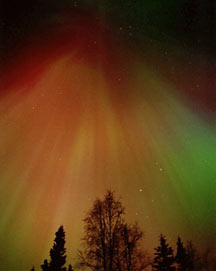|


|
Have you ever noticed the different colors in streetlights? Some are a dark yellow color while others have a blue or purplish light. How about neon signs? They have many different colors.
Streetlights and neon signs are filled with gas. When they are turned on, an applied voltage energizes electrons in the gas. These electrons strike the gas molecules, which excites them to emit light. The color of the light you see depends on the type of gas.
|
|
|

|
Above: rare high-altitude red aurora, caused by a violent solar outburst near solar maximum.
|
|
Every gas shines with its own special colors of light. These colors are like a fingerprint because no two gases give off exactly the same colors. Streetlights filled with sodium gas give off a dark yellow light. Only sodium atoms give off that particular shade of yellow. Orange neon signs are filled with pure neon gas. Other colors of neon signs are actually neon mixed with other types of gases, like helium or argon.
|
|
The unique colors of light produced by a gas are called its "
spectrum
".
The auroral lights' colors are determined by the spectra of gases in the Earth's atmosphere, and the height at which the most collisions take place. Incoming particles tend to collide with different gases at different heights.
|
|
|
Very high in the
ionosphere
(above 300 km or 180 miles), oxygen is the most common atom, and collisions there can create a rare red aurora. The strong yellow-to-green light that is most common is produced by collisions with oxygen at lower altitudes, between 100 and 300 km.
Around 100 km,
nitrogen molecules produce a red light that often seems to form the lower fringes on aural curtains. If our atmosphere were neon instead of oxygen and nitrogen, what color would auroral lights be? You guessed it, orange!
|
|
Lighter gases high in the ionosphere, like hydrogen and helium, make colors like blue and purple, but our eyes cannot always see them in the night sky. Good photographic film can be more sensitive to some colors than our eyes. Eyes see best in the green-yellow-orange part of the spectrum, where the Sun emits most of its light.
Right: a curtain aurora with red edges
|
|
© 1999-2001 Regents of the University of California
Observatory
/
The Exploratorium
This page was last updated
6/19/01
|

